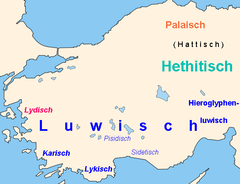Anatolian languages
The Anatolian languages form an extinct branch of the Indo-European language family and were found in Anatolia in the second and first millennium BC. . Chr spoken. Its most important representative is the Hittite . The oldest Indo-European written documents found so far ( 17th century BC ) are written in Hittite.
Origin and family relationships
The Anatolian languages form an independent branch of Indo-European . According to the theory, which is currently mostly represented in Indo-European Studies, the carriers of the Anatolian languages from the lower Volga region (southern Russia ) would probably have immigrated to Asia Minor via the Balkan Peninsula (alternatively via the Caucasus ) . Supporters of the competing Anatolia hypothesis (e.g. Colin Renfrew ) see Asia Minor itself as the original homeland of the Indo-Europeans .
The Anatolian languages are the oldest written Indo-European languages. At the moment, comparative considerations of Mycenaean Greek , the oldest Hittite written documents and the oldest Indian and Iranian written monuments assume a common original language roughly around 3000 BC. Chr . In 2005, Gert Klingenschmitt suggested the following. The Mycenaean dialect attested by written monuments around 1200 BC Chr. Already shows a historical orthography . The writing tradition of Greek is therefore likely to be older and around 1400 BC. . AD started. At that time the Greek was also already slightly differentiated dialectically, so that the first half of the second millennium BC is used for the ancient Greek . Chr. May assume. Urindo- Iranian, the assumed basic language of Indian and Iranian, should be enough in about the same time .
The earliest evidence of Hittite words (namely išpatallu , 'night quarters' and išḫuil , 'wage contract') in the ancient Assyrian texts of Anatolia (19th or 18th century BC, see Kültepe § Population ) suggests that the latest possible time for the Uranatolian at the end of the third millennium BC Chr. Lies. The hypothetical Indo-European or Indohethite original language would have to go back to around 3000 BC. BC or a little younger. (Much younger but not because the splitting of the Indo-European languages probably not occurring after the invention of the common basic vocabulary long wheel probably around 3500 v. Chr took place..) The often-made assumption of 4000 v. Klingenschmitt considers this unlikely. (Of course, this conclusion is all the more valid for the Anatolia hypothesis, which even assumes a date of around 7000 BC.)
Changes from Urindo-European to Anatolian
Phonology : the aspirated media have completely collapsed with the simple media; Tenues and * h₂ (probably [χ] as in Bach ) between unaccented Moren be voiced and merge with the result of this combination Falls. (Later the tenues become geminates , at least between vowels, and the media are voiceless.) The laryngals are often, in Uranatolian perhaps almost completely, preserved as their own phonemes , at least the second, and apparently also the third. The sound sequence * h₂w becomes an independent Uranatolian phoneme * χʷ . Unaccented long vowels inherited from Urindo-European are shortened. The continuation of the uridg. Long vowel * ē [eː] contrasts with the result of * eh₁ , which becomes a more open * ǣ [ɛː] . Uridg becomes early on, but possibly not yet in Uranatolian. * ei̯ monophthongized and falls with uridg. * ē together, while uridg. * eṷ coincides with * ū from other sources. Further developments are individual languages.
Nominal morphology : all cases of the Indo-European original language have been preserved; However, dative and locative have the same endings in Old Ethite. The ancient Ethite ablative and instrumental no longer differentiate between numbers. A feminine does not exist in Anatolian, at most traces (ie there is only one genus commune and one neuter); But there was probably no fully grammatical feminine in Urindo-European either. For this purpose, Anatolian developed split ergativity , marked by an "individualizing" suffix * -ent- , which allowed neuter to be used as the subject of transitive verbs.
Verbal morphology : The Anatolian verb system shows significant differences to the verbal morphology of the other Indo-European language branches. The Anatolian verb has two tenses (present and simple past), two modes (indicative and imperative) and two genera verbi (active and mediopassive). Subjunctive and optative have been lost. The ḫi conjugation probably stems from an archaic, unreduplicated root perfect (more precisely: root stand), otherwise only preserved in * ṷói̯d-h₂e "I know" and perhaps the Germanic preteritos .
Outline of the Anatolian branch
The Anatolian branch of the Indo-European languages is mostly divided into the following languages:
- Central Anatolian
- Western Anatolian
- Palaic
- Lydian
-
Luwish
- Cuneiform Luwish
- Hieroglyphics Luwish
- Pamphylian
-
Lycian
- Lycian A
- Lycian B or Millyian
- Carish
Luwian , Lycian , Carian , Pisidian, and Sidetable are occasionally grouped together as Luwian languages because they appear to be more closely related. Mallory and Adams divide the Palai with the Hittite into a separate subfamily.
Individual evidence
- ↑ JP Mallory, d. Q. Adams: The Oxford Introduction to Proto-Indo-European and the Proto-Indo-European World. Oxford University Press 2006, p. 29.
literature
- Gert Klingenschmitt: Language affinities in Europe. In: Genes, Languages and Their Evolution. Edited by Günter Hauska. Universitätsverlag, Regensburg 2005, p. 112. ISBN 3-930480-46-8
- Craig Melchert: Anatolian Historical Phonology . Rodopi, Amsterdam 1994.
- Sylvain Patri: L'alignement syntaxique dans les langues indo-européennes d'Anatolie ( studies on the Boǧazköy texts 49). Harrassowitz, Wiesbaden 2007. ISBN 978-3-447-05612-0
- Maciej Popko : Peoples and Languages of Old Anatolia. Harrassowitz, Wiesbaden 2008. ISBN 978-3-447-05708-0
Web links
- Digital etymological-philological Dictionary of the Ancient Anatolian Corpus Languages (eDiAna) . Ludwig Maximilians University of Munich . Retrieved March 14, 2017.
- Peoples and Languages of Ancient Anatolia , translation of the book Ludy i języki starożytnej Anatolii by Maciej Popko (PDF; 584 kB)
